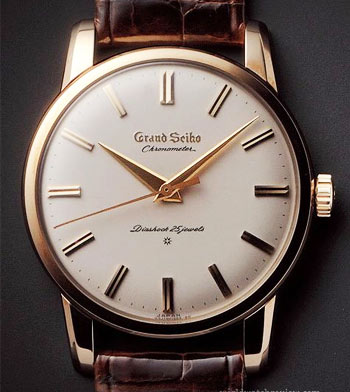The Evolution Of Time
"The times they are a changing" is a popular statement referring to the ongoing changes we experience daily. The adage also holds true with the transformation in the size of wristwatches during the past century. Once diminutive, slim and slender in size at their inception in the early 20th Century, wristwatches have grown in size to big and chunky proportions.
For generations luxury wristwatches have reflected an air of prestige and status. While these values do still hold true for many today, watches are more so now an indispensable fashion accessory. For today's fashion conscious men and women wearing the correct timepiece is just as important as wearing the appropriate shoes, belt, scarf and hat to complete an ensemble. And larger watches not only make a fashion statement, they become a focal point of the entire outfit.
Average Watch Case Size By Decade
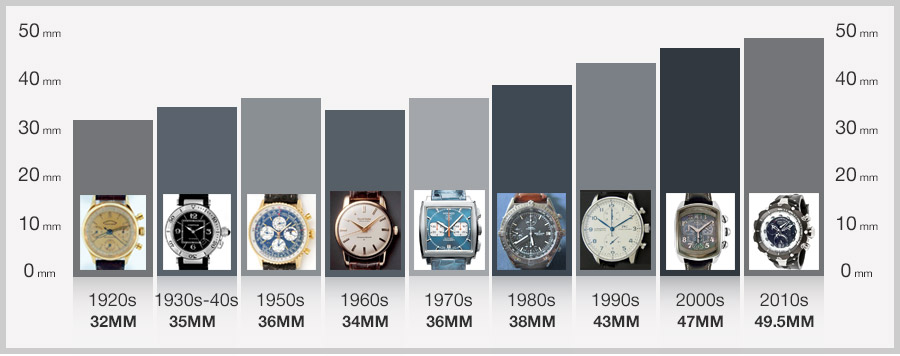
1900 - 1929The origin of wristwatches dates back to the early 1900s. Prior to this time period, pocket watches were worn attached to a chain or fob and kept in side pockets. In 1904, Louis Cartier created the Cartier Santos Watch as a favor for colleague Alberto Santos-Dumont, an aviator who wanted a timepiece he could wear on his wrist while flying, since pocket watches were very cumbersome to use. The Santos measured 31mm wide and 9mm thick. Several years later, Cartier introduced the Tank Watch, inspired by Renault tanks used during World War 1. The ultra-slim Tank watch measured 30mm wide and 6mm thick. The popularity of slim and slender watches during this era continued with the introduction of the slim rectangular shaped Movado Polyplan watch, measuring 19mm wide and 8mm thick, along with the Bulova Trojan timepiece, measuring 23mm wide and 10mm thick. In 1926 luxury watchmaker Rolex introduced the first water-resistant timepiece in the world. Named the Oyster, this dust-proof and water-resistant watch measured 26mm in diameter and 14mm thick. A year later English swimmer Mercedes Gleitze successfully swam the English Channel wearing the watch and reported that it remained in perfect working condition even after 10 hours in the water. | 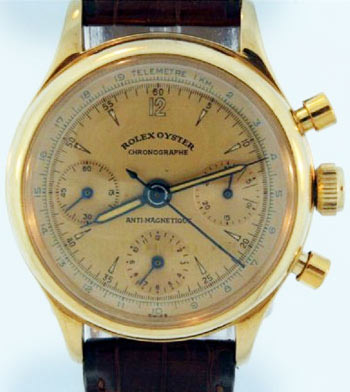 |
ROLEX OYSTER: 26MM/14MM |
1950 - 1959Men's and women's watches introduced during the 1950s are very much like the era they came from: many maintained the status quo in both style and size. In most cases, watches produced during this period held consistency in size growing just a few millimeters. Nonetheless, the era marked the introduction of important watch collections from Officine Panerai, Breitling, and Omega that are still being produced today. The Officine Panerai Luminor debuted in 1952 and featured a cushion case and patented protective bridge for superior water resistance. The case measured 40mm in diameter and 16mm thick and was one of the largest sized timepieces of this era. In 1952 Breitling introduced the Navitimer Chronograph, the world's first timepiece with a circular slide-rule bezel. The chronograph offered navigational time measurements and was expressly designed for airplane pilots. In fact the watch was endorsed by the Aircraft Owners and Pilots Association during the 1950s and 1960s, who had a special edition of this chronograph issued with the AOPA logo on the dial. The Omega Speedmaster chronograph watch debuted in 1957. It featured a 39mm round, 10mm thick case, stationary tachymeter bezel and domed Plexiglas crystal. While it was first introduced as a sports and racing wristwatch, this timepiece would later gain prominence in 1969, when it was designated by NASA as the "moon watch" and was worn by astronauts Neil Armstrong and Buzz Aldrin during the historic Apollo 11 flight to the moon. The Plexiglas crystal and dustproof characteristics of the Speedmaster gave Omega the edge against Bulova, who were both competing at the time to have the first watch on the moon. | 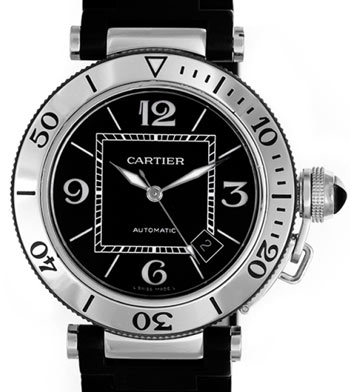 |
CARTIER PASHA: 35MM/9MM | |
1930 - 1949The origin of wristwatches dates back to the early 1900s. Prior to this time period, pocket watches were worn attached to a chain or fob and kept in side Wristwatches began to grow in size and stature from 1930s through the 1940s as many watchmakers started to move away from pocket watches and introduced timepieces for the wrist. The Hamilton Piping Rock watch was a popular choice in the early 1930s. Measuring 34mm in diameter and 10mm thick, this mechanical gold strap watch was originally designed in 1928 as a commemorative model for members of the New York Yankees including players Babe Ruth and Lou Gerhrig to honor their World Series victory earlier in the year. Only 35 pieces of the World Series edition were produced. A year later, Hamilton introduced the watch into wide distribution. Swiss watchmaker Longines debuted the Hour Angle in the early 1930s. The watch designed by legendary pilot Charles Lindberg featured a 38mm round, 10mm thick case on a leather strap and was designed to help aviators calculate the longitude on their journeys and determine their exact geographical location. Lindberg was also associated with the Bulova Lone Eagle timepiece, which he was the spokesman for after his non-stop flight across the Atlantic Ocean in 1927. The commemorative timepiece introduced in the early 1930's, featured a Tonneau shaped case on a leather strap. It measured 29mm wide and 9mm thick. Legendary Swiss watchmaker Lucien Piccard created many thin timepieces for men and women during this era, including the Seashark mechanical men's watch, which measured 30mm in diameter and 8mm thick. The widely popular Mickey Mouse watch from Timex also debuted during the 1930s. Measuring 31mm in diameter and 10mm thick, this colorful timepiece would prove to become a valuable and coveted collector's item decades later. Water-resistant timepieces progressed to higher standards in the early 1940s with the introduction of Cartier Pasha timepiece in 1943. The wristwatch is inspired by the model the Pacha of Marrakech commissioned Cartier to create in 1934 to allow him to be able to view his watch while swimming. It featured a protective locking cap on the crown that prevented water from entering the case and mechanical mechanism inside. The watch measuring 35mm in diameter and 9mm thick set the stage and further development of water-resistant watch technology. In 1948 horology history was made with the introduction of the Movado Museum watch. This iconic timepiece, which is still being produced today, pays homage to minimalist art. Designed by artist Nathan George Horwitt, the minimalist timepiece featured a 28mm round, 6mm thick gold case on a black leather strap. The black background on the dial was accented with two sword hands and a dot at the 12 o'clock hour. The same design is incorporated in many of the brand's watch collections today. | 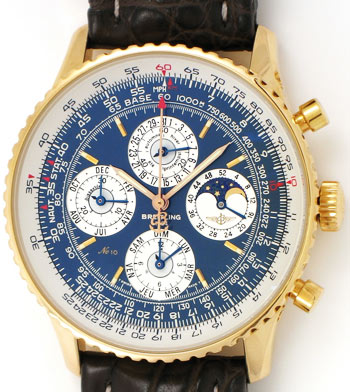 |
BREITLING NAVITIMER: 38MM/13MM | |
1950 - 1959Men's and women's watches introduced during the 1950s are very much like the era they came from: many maintained the status quo in both style and size. In most cases, watches produced during this period held consistency in size growing just a few millimeters. Nonetheless, the era marked the introduction of important watch collections from Officine Panerai, Breitling, and Omega that are still being produced today. The Officine Panerai Luminor debuted in 1952 and featured a cushion case and patented protective bridge for superior water resistance. The case measured 40mm in diameter and 16mm thick and was one of the largest sized timepieces of this era. In 1952 Breitling introduced the Navitimer Chronograph, the world's first timepiece with a circular slide-rule bezel. The chronograph offered navigational time measurements and was expressly designed for airplane pilots. In fact the watch was endorsed by the Aircraft Owners and Pilots Association during the 1950s and 1960s, who had a special edition of this chronograph issued with the AOPA logo on the dial. The Omega Speedmaster chronograph watch debuted in 1957. It featured a 39mm round, 10mm thick case, stationary tachymeter bezel and domed Plexiglas crystal. While it was first introduced as a sports and racing wristwatch, this timepiece would later gain prominence in 1969, when it was designated by NASA as the "moon watch" and was worn by astronauts Neil Armstrong and Buzz Aldrin during the historic Apollo 11 flight to the moon. The Plexiglas crystal and dustproof characteristics of the Speedmaster gave Omega the edge against Bulova, who were both competing at the time to have the first watch on the moon. | |
SEIKO GRAND SEIKO: 36MM/11MM | |
1960 - 1969Watchmakers from both ends of the spectrum: mass-market and luxury released many popular timepieces during this era. Bulova and Seiko were prominently featured in the 1960s as was Hamilton and Piaget. While the styles were innovative, the proportions remained constant. Although Bulova timepieces did not make it to the moon, their Spaceview timepiece was well received in the 1960s. This popular timepiece featured an exhibition skeleton dial, no exterior crown and a time setting mechanism on the back. It is the first mass-produced visible movement watch of its type. The case was 36mm in diameter and 11mm thick. Seiko watches came into global prominence during the 1960s and the Grand Seiko timepiece was one of the brand's first international successes. Measuring 36mm in diameter and 11mm thick, this self-winding automatic Japanese timepiece offered precision craftsmanship and accuracy at a more affordable price. In the luxury watch category, the decade can easily be defined by the popular Piaget Protocole gold timepiece, a slim and slender model featuring a rectangular shaped case that measured 34mm wide and 8mm thick. The Hamilton Ventura is one of the most popular watches of the era. This uniquely shaped triangular timepiece debuted in 1957 and gained world prominence when Elvis Presley wore one in the 1961 film "Blue Hawaii." The popular timepiece measured 31mm wide and 10mm thick. | 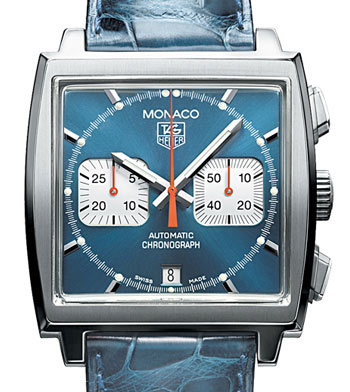 |
TAG HEUER MONACO: 37MMw/6MM | |
1970 - 1979The 1970's marked the beginning of the digital era as American and Japanese watchmakers Hamilton and Seiko introduced quartz timepieces with futuristic digital dials. While the styling of these timepieces took a giant leap forward, their size decreased in proportion. The Hamilton Pulsar watch with a 34mm wide, 11mm thick case and four-digit dial was introduced in 1970. In 1973 Seiko followed with the world's first six-digit digital watch, which featured a 32mm wide, 11mm thick case. Many additional digital models were released by both brands and many other popular watchmakers including Citizen and Bulova. Citizen, another Japanese brand came into world importance during the decade. The brand's Promaster automatic diving watch was introduced in the early 1970s, while the Citizen of America Corporation was established in 1975. The gold plated automatic diver's watch featured a 40mm diameter, 12mm thick case. Swiss watchmaker TAG Heuer gained worldwide popularity in the 1970s with the release of the motion picture "Le Mans" featuring actor Steve McQueen wearing a Monaco chronograph in the film. With the popularity of the film and its lead performer, the square shaped 37mm wide, 6mm thick chronograph was a global sensation and still remains popular forty years later. | |
1980 - 1989Luxury timepieces flourished during the early 1980s with introductions of the Piaget Polo wristwatch and the Amadeus timepiece from Raymond Weil. Both timepiece collections offered slender cases less than 35mm in diameter and 12mm thick. The decade also marks the introduction of the Seiko Kinetic watch, the first quartz timepiece with a hand-winding generating system that required no replacement batteries. This revolutionary timepiece was also extremely lightweight and measured 32mm in diameter and 11mm thick. The late 1980s also saw the appearance of the Breitling Chronomat Chronograph and TAG Heuer Formula 1 timepiece. Both series offered larger sized models. The former featured cases 40.5mm in diameter and 15mm thick. The latter collection offered cases as large as 44mm in diameter and 12mm thick. | 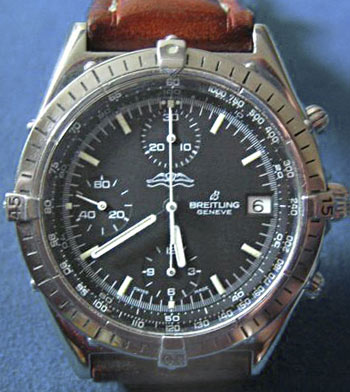 |
BREITLING CHRONOMAT: 40.5MM/14.7MM | |
1990 - 1999Striking contrasts best describe the last decade of the 20th Century. Wristwatches at the outset were ultra-thin and lightweight. The Cartier Tank Francaise and Longines La Dolce Vita, both introduced in the early 1990s featured rectangular shaped cases 26mm wide and less than 10mm thick. The Raymond Weil Parsifal and Rolex Daytona chronograph released in 1991 featured cases 34mm in diameter or less and 10mm thick. Timepieces of a larger size magnitude were introduced as the century came to a close. The TAG Heuer Sel Series and Officine Panerai Radiomir wristwatches launched in the late 1990s with cases 41mm in diameter or more and over 12mm thick. Meanwhile, and IWC Portuguese debuted at the same time with a 44mm diameter and 15.5mm thick case. The era also ended with the launch of a new brand TechnoMarine, which offered men's-size 38mm round chronographs for women with diamond bezels and silicone gel straps. The trend-setting brand not only made it fashionable for women to wear chronographs but men's-size watches as well. | 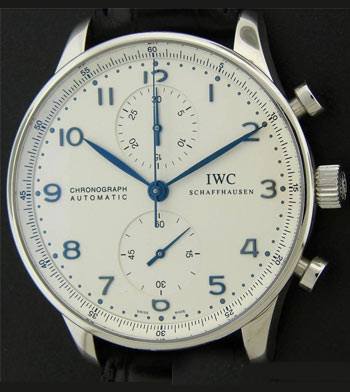 |
IWC PORTUGUESE: 44.2MM/15.5 | |
2000 - 2009The new Millennium offered many new exciting changes for wristwatches. Bold highly pronounced timepieces were introduced during the decade and were widely received. While thin watches from the Citizen Stiletto and Skagen 2000 series featuring cases less than 36mm in diameter and 6mm thick were popular, larger size watches from Invicta, Lucien Piccard, TAG Heuer and even Cartier were introduced to widespread acclaim. Invicta set the stage for oversized men's watches with the introduction of the Lupah series featuring 47mm wide, 19mm thick cases and the Pro Diver Series with cases 55mm in diameter and 15mm thick. The TAG Heuer Link Series introduced early in the decade, featured cases 44mm in diameter and 15mm thick. The IWC Big Pilot's watch followed with cases 46mm in diameter and 14mm thick. As the decade came to a close, luxury watchmakers Cartier and Lucien Piccard both introduced larger sized timepieces as well. Cartier debuted a new, updated model of its renowned Santos wristwatch with the Santos 100, which measured 51mm wide and 15.5mm thick. The Stratosphere wristwatch featuring two separate dials in a unique trapezoid shaped case was introduced by Lucien Piccard. This modern, innovative timepiece commands attention of the wrist with a 49mm wide and 21mm thick case. |  |
INVICTA LUPA: 47MM/19MM | |
2010 - PresentThe term "Size Matters" easily paraphrases the scope of today's watch styles as every popular watchmaker now features large, oversized timepieces for men and women in their assortment. Top-selling brands Swiss Legend, Invicta, Citizen, Seiko, Timex and Bulova offer many watches over 46mm in diameter. The Invicta Venom Reserve with a 56mm diameter, 21mm case and the Swiss Legend Neptune featuring a 52mm diameter, 19mm thick case are standouts in size and design. Both styles feature generously sized cases and dynamic good looks. Designer watches from Michael Kors and Movado make a fashion statement with their stylish appeal and dramatic size. The Movado Bold wristwatch offers a modern interpretation of the brand's Musuem watch with a 42mm diameter case and colorful splashes of color on the dial and strap. Michael Kors Lexington Chronograph features a generously sized case that is 46mm diameter and 15mm thick. Luxury watchmakers Breitling, Officine Panerai and U-Boat, known for their larger size models in the past decade, introduced even larger styles. The new Breitling Navitimer comes in at 49mm in diameter and 15mm thick, while the Panerai Radiomir is 47mm in diameter and 16mm thick. The U-Boat Classico is the leader of the pack with a strapping case that is 55mm in diameter and 19mm thick. | 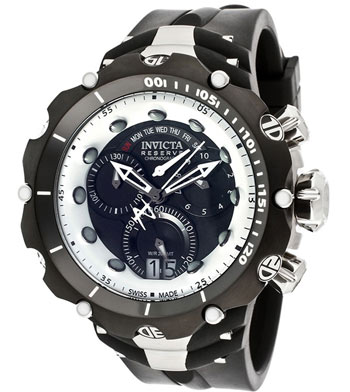 |
INVICTA VENOM RESERVE: 51MM/21MM |

